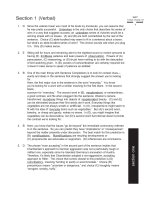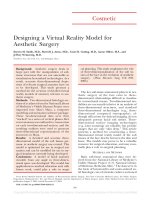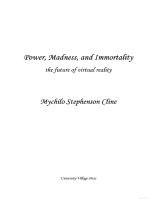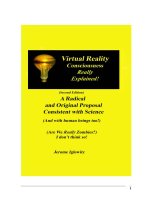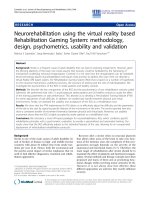Virtual Reality - Consciousness Really Explained! pptx
Bạn đang xem bản rút gọn của tài liệu. Xem và tải ngay bản đầy đủ của tài liệu tại đây (4.67 MB, 606 trang )
1
2
Virtual Reality: Consciousness Really
Explained!
(Second Edition)
Jerome Iglowitz
(February 22, 2010)
3
4
Copyright
February 8, 2010
Jerome Iglowitz
5
6
Dedication:
For Chen
Who has taught me more about courage
Than I had ever known.
7
8
9
A Note for Impatient or Skeptical Minds
Impatient or skeptical minds should probably begin the
New Précis, (“In a Nutshell”) –at the very beginning of Chapter 1
and then skip to Chapter 12 which show two relatively
contemporaneous criticisms of my ideas and my answer to them.
1
I
This should resolve many difficulties before they start.
This is clearly a very difficult subject to present with any other
perspective than the standard ones: i.e. the very ones that have
already clearly failed! Give me some space and I’ll try to make a
revolutionary out of you! I think the answer is important.
On the other hand, let me insert an apology at this point. I
am currently 71 years old, and have had several strokes which
have impaired my abilities. And yet, I consider the new content
1 (Note: This is the second edition of “Virtual Reality: Consciousness really Explained”
which was completed in 1995, (revised 1998). Though it lacks some of the detail of the
former, it incorporates a later and richer perspective with much n
ew material and
elucidates my second thesis far better than the original. I do not think it changes,
but rather enriches the substance and sense of the earlier edition and clarifies its
rationale. This version uses a mix of footnotes and endnotes. The footnotes, (in
ordinary numerals), are necessary for immediate clarity, but I felt the material
included in the endnotes, (in Roman numerals), interrupted the flow of thought.
Hence it was relegated to its endnote status.)
of this book important. What it is lacking is an overall stylistic
form of sufficient refinement to do it justice as my concentration
has been narrowed to specific problems which I have responded
to and which I think make my perspective clearer. Some of the
citation references might need “tweeking”, but that should be
achievable with minimal effort given sufficient interest. This is
the “hard problem” and you’d better begin by expecting it to be
so.
Jerome Iglowitz, 2010
10
Table of Contents
VIRTUAL REALITY: CONSCIOUSNESS REALLY EXPLAINED! 3
COPYRIGHT 5
DEDICATION: 7
A NOTE FOR IMPATIENT OR SKEPTICAL MINDS 9
TABLE OF CONTENTS 11
PREFACE: 19
PREAMBLE: 23
CHAPTER 1. INTRODUCTION AND NEW PRÉCIS: “IN A
NUTSHELL” 27
EMERGENCE 28
A VERY BASIC ARGUMENT 30
THE “HARD CORE”: 35
David Hilbert: 36
Maturana and Freeman: 38
Kant 41
OLD PRECIS FOLLOWS: 41
The Brain: A Materialist Perspective: 41
The “Mental” Perspective: 46
The Concordance: 47
“Symbolic Forms” 48
“The Interface” 49
11
CHAPTER 2: EXOTIC MATHEMATICS: WHAT IS IT, AND HOW IS
IT RELEVANT TO THE MIND-BRAIN PROBLEM? 53
(A DEEPER LOOK AT HILBERT.) 53
MATHEMATICAL STRUCTURALISM AND CATEGORY THEORY: 65
BACK TO THE MATHEMATICAL PROBLEM: 84
BACK TO THE SOURCES OF CATEGORY THEORY AND STRUCTURALISM:
86
SHAPIRO PART ONE 86
CHAPTER 3: ADVENTURES OF THE MIND: A CRITICAL TURNING
POINT AND THE ORIGINS OF MY CONCEPTION 97
CASSIRER AND LOGIC: 98
ON CANTOR’S DIAGONAL ARGUMENT –WRITTEN 50 YEARS AGO! 112
A REITERATION OF MY LATER REFLECTIONS ON CANTOR’S ARGUMENT 115
A POWERFUL ARGUMENT FOR THE STRUCTURALIST PERSPECTIVE 119
MY CONCLUSION: 120
THE CONCEPT OF IMPLICIT DEFINITION 125
BUT HOW CAN WE CONCEIVE OF PURELY OPERATIONAL OBJECTS AS
CORRELATING WITH THE REAL WORLD
? 128
THE ANTHROPIC PRINCIPLE 131
BACK TO MAC LANE AGAIN: 132
A FINAL COMMENT BY CASSIRER RELEVANT TO THIS CURRENT PROBLEM133
Mac Lane category theory 136
BACK TO SHAPIRO: 141
THE ROSEN LETTER: (A REFLECTION ON SHAPIRO’S POSITION) 143
MODERN PTOLEMEAN PHYSICS 146
LOGIC AS BIOLOGY: 150
CHAPTER 4: MY FIRST HYPOTHESIS IN DETAIL: (BIOLOGY
PART ONE) 153
1. REPRESENTATION: THE PERSPECTIVE FROM BIOLOGY 153
12
2. “THE SCHEMATIC MODEL”: DEFINITION AND EXAMPLES 155
2.1 The Simplest Case: A Definition by Example 155
2.1.1 Reversing our perspective: 161
2.2 A Case for Schematism More Specific to Our Special Problem:
Narrowing the Focus 163
(The Engineering Argument) 163
2.3 The “G.U.I.”, the Most Pertinent and Sophisticated Example of a
Schematic Model: the Special Case) 165
A Graphic Rendering of Edelman’s Epistemology: Figure 12: 169
2.4 Towards a Better Biological Model 171
2.4.1 Biology, The Real Thing: Freeman’s Model 171
Walter J. Freeman 171
The Peripheral Code: 176
Cortical Mapping is Very Different, However: 177
2.4.2 An Explicit Model of the Mind: 183
GOD’S EYE? 186
ON P.S.CHURCHLAND: 187
3. THE FORMAL AND ABSTRACT PROBLEM: 187
3.1 The formal argument 187
3.2 The Specific Case of Biology 190
Turning our Perspective Around 190
3.3 Retrodictive Confirmation 193
A Profound Teleological Consequence 193
3.4 Conclusion, (section 3) 194
4. THE CONCORDANCE: BIOLOGY’S PROPER CONCLUSION 195
5. PLAIN TALK: 199
BOUNDS AND LIMITS 204
APPENDIX, (FREEMAN & AUTOMORPHISM) 206
FIGURE 19: GOD’S EYE? 210
CHAPTER CONCLUSIONS: 212
CHAPTER 5: MY SECOND HYPOTHESIS –A SHORT SKETCH 217
13
AN ASIDE FOR CLARIFICATION: 218
THE CONCEPT OF IMPLICIT DEFINITION 224
CHAPTER 6: MATURANA & VARELA & KANT BIOLOGY-PART II
227
TOWARDS THE WHERE AND THE WHAT? 227
CLOSURE: 231
MATURANA AND VARELA: 238
“TRIGGERING” VS “CAUSATION”: 244
THE CONSERVATION OF AUTOPOIESIS: 246
BEHAVIOR AS AN ASPECT OF STRUCTURAL COUPLING: 247
OPERATIONAL CLOSURE: 249
THE STRUCTURAL PRESENT: 251
MATURANA’S PARADOX 254
THE AXIOM OF EXTERNALITY 268
RELATIVIZED MATERIALSM 278
AN ANSWER TO THE NEW DILEMMA: 278
KANT’S CRITICAL IDEALISM: 279
A NEW AND MORE RECENT PERSPECTIVE ON MATURANA: 284
THE PARALLEL POSTULATE 289
CHAPTER 7: COGNITION AND EXPERIENCE 294
QUINE AND CASSIRER 294
A FANTASY: 297
THE AXIOM OF EXPERIENCE: 302
THE EPISTEMOLOGICAL PROBLEM: 303
CASSIRER REVISITED: 309
THE AXIOM OF EXPERIENCE 313
CASSIRER'S THEORY OF SYMBOLIC FORMS, AN ANALYSIS: 314
14
CHAPTER 8: CASSIRER’S “SYMBOLIC FORMS” -THE SOLUTION
TO MY OWN EPISTEMOLOGICAL DILEMMA –AND A PROFOUND
CHANGE IN PERSPECTIVE 330
WHENCE CASSIRER'S THESIS: 334
CONTRA CASSIRER: (WHAT ARE THE REAL PARAMETERS?) 339
THE POWER OF NATURALISM: 355
CHAPTER CONCLUSIONS: 366
CHAPTER 9: A SIMPLER ALTERNATIVE APPROACH TO
CASSIRER’S SYMBOLIC FORMS: “MATHEMATICAL IDEALS”:370
AN ALTERNATIVE APPROACH TO CASSIRER'S AND MY IDEAS:
“MATHEMATICAL IDEALS”: 371
CASSIRER’S THEORY OF SYMBOLIC FORMS: 378
THE SUBSTANCE OF MIND: 380
CHAPTER 10: “THE INTERFACE” 384
THIS IS MY PERSONAL METAPHYSICAL ASSERTION! 385
CHAPTER 11: THE LAST HURDLE 388
THE THIRD HYPOTHESIS: A FORMAL STATEMENT: 389
A FORMAL STATEMENT OF MY THIRD HYPOTHESIS: 391
CHAPTER 12: TWO (RELATIVELY) CONTEMPORARY REALIST
CRITICISMS OF MY CONCLUSIONS 394
DURANT ON KANT: 395
DURANT CRITIQUES KANT: 405
THE JCS REVIEW 409
WHERE CASSIRER AND I FUNDAMENTALLY DIFFER: 420
THE ANTHROPIC PRINCIPLE 425
CASSIRER AND GOD’S EYE: 425
IN DEFENSE OF KANT: 430
CHAPTER 13: CONCLUSIONS &OPINIONS 434
15
SCIENTIFIC CONCLUSIONS: 434
SO WHERE DO WE GO FROM HERE? 434
DEVIL'S ADVOCATE: 435
SO WHY BOTHER? 438
HOW DO WE LIVE? 440
MY "ACT OF FAITH": 441
CHAPTER 14: EPILOGUE 443
CHAPTER 15: BOOK CONCLUSION 451
APPENDIX A:THE DENNETT APPENDIX AND THE COLOR PHI,
(FROM IGLOWITZ 1995) 455
TOWARDS A WORKING MODEL OF REAL MINDS: DENNETT, HELMHOLTZ
AND
CASSIRER 456
CASSIRER ON THE COLOR PHI: 464
AN EXTENSION OF THE SCHEMATIC MODEL: A BRIEF SKETCH 467
A THOUGHT EXPERIMENT 469
APPENDIX B: LAKOFF, EDELMAN, AND “HIERARCHY” 475
LAKOFF: 476
The Classical Concept 477
Cassirer and Lakoff’s Logic 486
Putnams’ Requirements 498
Lakoff’s ICM’s 505
Maturana: 506
EDELMAN: 509
God’s and Edelman’s Eye 514
On “Presentation” 515
Re-entrant Maps 517
What Edelman has not solved: the problem of the Cartesian Theatre 521
On Epistemology: 526
16
Conclusion 535
APPENDIX C: CASSIRER AGAIN 537
HOW? THE LOGICAL PROBLEM OF CONSCIOUSNESS 537
(CASSIRER- HILBERT- MATURANA: AN ARCHIMEDEAN FULCRUM) 537
CASSIRER AND CLASSICAL LOGIC: 541
CONCEPT VS. PRESENTATION: 542
CONTRA THE THEORY OF ATTENTION: 545
MAJOR CONSEQUENCES: 547
RE PRESENTATION: 548
THE CONCEPT OF IMPLICIT DEFINITION: 552
IMPLICIT DEFINITION VIS A VIS PRESENTATION: 559
WHY IS THIS RELEVANT TO MIND? 563
CONTRA CASSIRER: 567
THE CRUX OF THE ISSUE: PRESENTATION 570
BIBLIOGRAPHY 573
ENDNOTES 581
17
19
Preface:
There is a wonderful though longish passage by the
famous logician W.V.O.Quine
2
which I will quote in its entirety
to serve as an introduction:
"The totality of our so-called knowledge or beliefs, from
the most casual matters of geography and history to the
profoundest laws of atomic physics or even of pure
mathematics and logic, is a man-made fabric which
impinges on experience only along the edges. Or, to
change the figure, total science is like a field of force
whose boundary conditions are experience. A conflict
with experience at the periphery occasions readjustments
in the interior of the field. Truth values have to be
redistributed over some of our statements. Reevaluation
of some statements entails reevaluation of others, because
of their logical interconnections- the logical laws being in
turn simply certain further statements of the system,
certain further elements of the field. Having reevaluated
one statement we must reevaluate some others, which
may be statements logically connected with the first or
2
(recently deceased)
may be the statements of logical connections themselves.
But the total field is so underdetermined by its boundary
conditions, experience, that there is much latitude of
choice as to what statements to reevaluate in the light of
any single contrary experience. No particular experiences
are linked with any particular statements in the interior of
the field, except indirectly through considerations of
equilibrium affecting the field as a whole
Furthermore it becomes folly to see a boundary between
synthetic statements… and analytic statements Any
statement can be held true come what may, if we make
drastic enough adjustments elsewhere in the system
Conversely… no statement is immune to revision… even
the logical law of the excluded middle and what
difference is there in principle between such a shift and
the shift whereby Kepler superseded Ptolemy, or Einstein
Newton, or Darwin Aristotle?"
II
And another much shorter quote from another of his
writings which displays the full extent of his horizons:
"One could even end up, though we ourselves shall not,
by finding that the smoothest and most adequate overall
account of the world does not after all accord existence to
ordinary physical things Such eventual departures from
Johnsonian usage”, (Samuel Johnson is said to have
demonstrated the reality of a rock by kicking it!), “could
20
partake of the spirit of science and even of the
evolutionary spirit of ordinary language itself."
III
This has always been my personal goal – i.e. of “finding
…. the smoothest and most adequate overall account of the
world” –but to include my own mind as well! But it will involve
a conceptual framework as large as Quine’s.
Piaget had a relevant comment which I think is
applicable. The famous child psychologist was interested in the
foundations of mathematics as a secondary interest. He evaluated
mathematical Platonism, and concluded, (paraphrasing):
“if a mathematician (thinker), were to arrive at some
conclusions that neither he nor his readers were able to
fully understand, and if he were to write these conclusions
down, (that is, to date stamp them), and if, furthermore,
they were found to be correct at some future time –then
the conclusive case for Platonism would be made.”
I think the argument is applicable to ideas in general. If
I am right in my conclusions, (and I do not dogmatically claim
that I am), then the future of science will come to my perspective
asymptotically. When and if that happens, hear me again! I will
probably be gone, but my cause will not be.
Finally, let me cite Kepler regarding his profound
revelations in astronomy:
“Now, since the dawn eight months ago, and since a few
days ago, when the full sun illuminated my wonderful
21
speculations, nothing holds me back. I yield freely to the
sacred frenzy; I dare frankly to confess that I have stolen
the golden vessels of the Egyptians to build a tabernacle
for my god far from the bounds of Egypt. If you pardon
me, I shall rejoice; if you reproach me, I shall endure.
The die is cast, and I am writing the book –to be read
either now or by posterity, it matters not. It can wait a
century for a reader, as god himself has waited six
thousand years for a witness.”
IV
Take care, and good luck, Jerry Iglowitz 2010
22
23
Preamble:
Let me state at the outset that I am as much a realist as
any one of you –maybe more so. I enjoy, and fear as well, my
naïve reality at least as much as anyone
3
. It is the foundations of
realism I question. But so does realism itself. Science
continually changes the rules of the game. The world is no
longer truly made up of the simple atoms of Democritus, nor is it
made up of the subatomic particles of Bohr and Heisenberg. It is
made up of whatever it is that was most recently proposed –and
seems to work- as “substance” or “material”. Supposedly
hierarchy and emergence resolve the difficulty, but is this, in fact,
true?
4
(See footnote –it is a total misuse of legitimate concepts
drawn from other disciplines!)
3
I have lived more on the “rough side” of life probably more than most of my
expected readers, though less so than many others who have been forced to deal
with unimaginable horrors.
4
“Emergence” supposedly solves the problem of hierarchy in materialist
explanations of the mind-brain problem. It purportedly explains how new
phenomena “emerge” from more fundamental explanations. These new
emergent phenomena are said to embed themselves hierarchically in ontic
material -taken at the deepest level. The conception seems to derive from, or at
24
It is the phenomenology of realism –those relations that
work -and the “naïve realistic world” itself –that hard, cold,
violent, passionate and very concrete reality we all must live in
least be analogous to the embedding of mathematical explanations –or of
computer languages, (high vs low level languages). In point of fact, however,
we are allowed to embed some higher level axiom system, (or computer
language), in some more fundamental or different axiom system or language if
and only if we can prove/derive each of the axioms, (or new computer language
terms), of the higher system from the lower one. But that implicit level of proof
is always there. No new “phenomena” are allowed to exist in the former that
cannot be reduced to perhaps more complicated implications of the grounding
system. (One need only replace any usage of the axioms, (terms), of the higher
system with its proof system in the lower to derive the same result.) Nothing
radically new comes from such an approach. The rationale for instituting the
higher system derives from operational simplicity. Nothing emerges –hierarchy
will not allow it. In the computer language example, all the computer itself ever
sees is machine language!
Materialist explanations of consciousness of the usual sort all have this flaw. As
I will state the problem later: “how can a (biological) machine/mechanism
whose parts are discrete in time and space ever know anything whatsoever? But
I mean “knowing” in a different sense than simple mechanical, “zombie-like”
performance, and I think you wish it to be taken so too. “Consciousness” could
never arise in any normal sense of the word! It would constitute too great a
divide from the current, and specifically (meta
)physical models of brain
function.
25
and survive in that must be preserved. But the ever changing
substance of the “objects” per se of realism is at constant peril. I
wish to severely question realism’s ultimate “objects” themselves
to resolve the deepest dilemma of mankind: i.e. the mind-body
relationship.
But I must do so in a way that preserves the realism of
science, the realism of the naïve world, and the reality of the
mind which perceives them both. This is the core and the center
of my conception. I think that all of us, deep down, accept these
perspectives as our most fundamental realist presuppositions. It
is in the attempt at their mutual resolution that this pervasive
paradox endures.
It has been said of my work
5
that I am simply repeating
Kant. This is fair in one perspective –I am very much like Kant
insofar as the “What” of reality is concerned, though we differ
about the categories and ethics, and fundamentally about
epistemology. My particular thesis consists in supplying the
actual “How” and the “Why” –and the “Where”- of Kant’s
profound insight however, and which he never even attempted to
5
By an anonymous JCS reviewer who questioned my claim of the novelty and
the “outrageousness” of my proposal.
